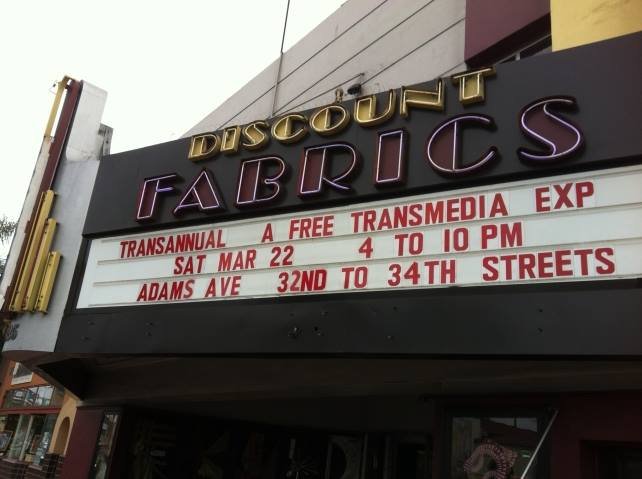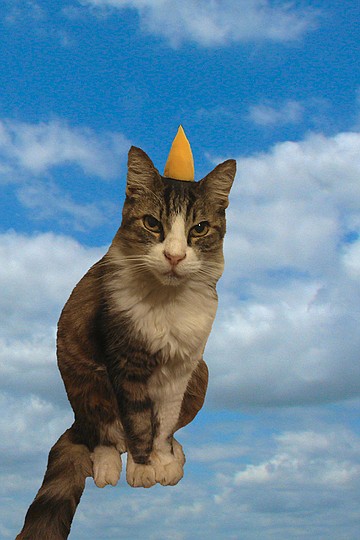 Facebook
Facebook
 X
X
 Instagram
Instagram
 TikTok
TikTok
 Youtube
Youtube

“We, as many artists, divorce ourselves in a sense, whether it’s conscious or not, from the notion that we’re making something to be displayed for sale so that someone can collect it,” says Robyko Sanchez. “We create work that’s exposing people to an experience that the aesthetic of an idea isn’t tied to an object as a saleable thing. In other words, we’re creating experiences as opposed to products.”
Robyko is actually two people: Robert Sanchez and his wife and partner-in-art, Emiko Lewis-Sanchez. Together, along with two others artists, Tony Allard and Jason Gould, Robyko is presenting the first TRANSANNUAL: Normal Actions for Normal Heights event — “trans” to represent the focus on “transmedia” (I’ll get to that in a moment), and annual, because they’re intending for this event to occur each year.
"Transmedia" is a fairly new term being batted around in arts academia to describe new genres of art mediums, including digital technology. “Specifically, transmedia is performance art and new media,” Robyko explains. “You can use painting or drawing, but it’s not the focus — the focus is on performance art and installation that is site-specific.”
On Saturday, March 22, from 4 to 10 p.m., eight artists and their teams of collaborators will fill four blocks on Adams Avenue (from 32nd to 34th Streets) with over a dozen installations. “We came up with this idea of starting a new event that separates ourselves from the usual art fairs where there’s just a sea of booths, and also with a focus on commodity, on people buying artwork. We didn’t want to have an art event that did that — instead, we wanted an art event where people came to experience things.”
Passersby will happen upon artwork both on the sidewalk and in some storefronts. “There is no schedule, no maps, no event organizer,” Robyko says. “There will be things happening on every block, both sides.”
Though they’re reluctant to give much away (all part of the freeform nature of the happening), I managed to get an example of one of the performance pieces. On the block of Adams Avenue from 32nd to Bancroft, there’s an old awning with the word “telephone” on it. Robyko explains it as a place where you know there was a telephone years ago, and the phone has been removed, but the area that housed it, with green tiles and the awning, is still there. “Nothing exists except the indication that this was once a telephone booth.”

The piece is called “televoguing.” Students from different art departments at both Cal State San Marcos and Mesa will strike “telephone gesture poses” to the sound of recorded dialogue from telephone calls “from movies, both well known and obscure, both English and other languages.” The students, and anyone happening by who might want to participate, will make facial expressions or position their bodies in ways that reflect the dialogue currently playing. This is one of “about 15 or 16 different sites” that will be set up.
There will be some stationary pieces, some mobile, and, as it gets darker, experimental film will be projected. “Think of it as an open studio,” says Robyko. “All these artists are collaborating to make this event happen. Out there, this is our studio, and we’re working from four to ten. Whatever occurs — set up, tear down, actual performance — individuals come upon it. It’s an experience.”
There are no immediate plans to monetize this event. “In a time when the arts are in a precarious situation, particularly liberal arts, they say if it’s not worth anything then why are you doing it,” Robyko explains. “For us, it’s about art — art is not about commodity, it’s about dialogue, a search for knowledge, truth, authenticity, process, and just because we want to do it. The idea of TRANSANNUAL is to create works just for the sake of creating something.”


“We, as many artists, divorce ourselves in a sense, whether it’s conscious or not, from the notion that we’re making something to be displayed for sale so that someone can collect it,” says Robyko Sanchez. “We create work that’s exposing people to an experience that the aesthetic of an idea isn’t tied to an object as a saleable thing. In other words, we’re creating experiences as opposed to products.”
Robyko is actually two people: Robert Sanchez and his wife and partner-in-art, Emiko Lewis-Sanchez. Together, along with two others artists, Tony Allard and Jason Gould, Robyko is presenting the first TRANSANNUAL: Normal Actions for Normal Heights event — “trans” to represent the focus on “transmedia” (I’ll get to that in a moment), and annual, because they’re intending for this event to occur each year.
"Transmedia" is a fairly new term being batted around in arts academia to describe new genres of art mediums, including digital technology. “Specifically, transmedia is performance art and new media,” Robyko explains. “You can use painting or drawing, but it’s not the focus — the focus is on performance art and installation that is site-specific.”
On Saturday, March 22, from 4 to 10 p.m., eight artists and their teams of collaborators will fill four blocks on Adams Avenue (from 32nd to 34th Streets) with over a dozen installations. “We came up with this idea of starting a new event that separates ourselves from the usual art fairs where there’s just a sea of booths, and also with a focus on commodity, on people buying artwork. We didn’t want to have an art event that did that — instead, we wanted an art event where people came to experience things.”
Passersby will happen upon artwork both on the sidewalk and in some storefronts. “There is no schedule, no maps, no event organizer,” Robyko says. “There will be things happening on every block, both sides.”
Though they’re reluctant to give much away (all part of the freeform nature of the happening), I managed to get an example of one of the performance pieces. On the block of Adams Avenue from 32nd to Bancroft, there’s an old awning with the word “telephone” on it. Robyko explains it as a place where you know there was a telephone years ago, and the phone has been removed, but the area that housed it, with green tiles and the awning, is still there. “Nothing exists except the indication that this was once a telephone booth.”

The piece is called “televoguing.” Students from different art departments at both Cal State San Marcos and Mesa will strike “telephone gesture poses” to the sound of recorded dialogue from telephone calls “from movies, both well known and obscure, both English and other languages.” The students, and anyone happening by who might want to participate, will make facial expressions or position their bodies in ways that reflect the dialogue currently playing. This is one of “about 15 or 16 different sites” that will be set up.
There will be some stationary pieces, some mobile, and, as it gets darker, experimental film will be projected. “Think of it as an open studio,” says Robyko. “All these artists are collaborating to make this event happen. Out there, this is our studio, and we’re working from four to ten. Whatever occurs — set up, tear down, actual performance — individuals come upon it. It’s an experience.”
There are no immediate plans to monetize this event. “In a time when the arts are in a precarious situation, particularly liberal arts, they say if it’s not worth anything then why are you doing it,” Robyko explains. “For us, it’s about art — art is not about commodity, it’s about dialogue, a search for knowledge, truth, authenticity, process, and just because we want to do it. The idea of TRANSANNUAL is to create works just for the sake of creating something.”
Comments